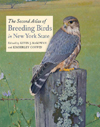 I’m a New Yorker. I was born in the Hudson Valley and grew up in the Catskills, went to school in the Southern Tier, lived in Albany, our capital city, explored the Adirondacks and the North Country, repeatedly visited western New York and now live in New York City, easily the best city in the world. I’m also a birder, you know, in case you haven’t noticed. So when The Second Atlas of Breeding Birds in New York State was announced ready for release, well, I was looking forward to it. Now that I have a copy of the book in my hands I must say that it was worth the wait. To put it simply, every New York birder should want one, as should anyone who plans to write a similar guide for their own state.
I’m a New Yorker. I was born in the Hudson Valley and grew up in the Catskills, went to school in the Southern Tier, lived in Albany, our capital city, explored the Adirondacks and the North Country, repeatedly visited western New York and now live in New York City, easily the best city in the world. I’m also a birder, you know, in case you haven’t noticed. So when The Second Atlas of Breeding Birds in New York State was announced ready for release, well, I was looking forward to it. Now that I have a copy of the book in my hands I must say that it was worth the wait. To put it simply, every New York birder should want one, as should anyone who plans to write a similar guide for their own state.
This second atlas, twenty years after the publication of the first, is the result of five years of survey work by the birders of the Empire State, editing by Kevin McGowan and Kimberley Corwin, the support and cooperation of the New York State Ornithological Association (of which I am a proud member), the New York State Department of Environmental Conservation, New York Cooperative Fish and Wildlife Research Unit, the Cornell University Department of Natural Resources, the Cornell Lab of Ornithology, and Audubon New York. The acknowledgments section of the book is twelve pages long, with seven of those being a list of the over twelve hundred birders who took part in the 2000-2005 Breeding Bird Atlas Survey, from which comes the data for the book. Fifteen different artists’ works are in the well-illustrated book, which includes a very nice cover painting of a perched Merlin clutching a dead Henslow’s Sparrow (incidentally, Merlins went from being found breeding in none of the survey blocks in the 1980-85 survey to being possibly, probably or confirmed breeding in 131 in the new survey).
But what is a survey block? Well, the Breeding Bird Atlas Survey methodology led to the entire state being divided into precisely 5,333 blocks, each measuring five kilometers on a side. This is actually two less than in the first survey because one of the blocks from the first survey was found later to be entirely in Canada (oops!) and one block, that had held only a small bit of sand in the early eighties by the twenty-first century held only water. What the atlas does is take the raw data from all of those blocks from all over the state and present it in a very pretty package.
The book has so much in it I am amazed it does not burst its bindings. What species shows up in the most atlas blocks? The American Robin, which appears in 98.2% of the blocks, dethroning the Song Sparrow. Other interesting tidbits are that while eight species increased their presence in the state by 1,000 blocks or more, only one species, the Brown Thrasher, decreased by 1,000 blocks or more. Each bird that breeds in the state has its own two page summary, one page of which is mostly text describing the history of the bird in the state and also a black-and-white drawing or painting of the bird. The second page of each species listing is two maps which show the results first of the 2000-05 atlas work and the second which overlays that data with the data from 1980-85. Also on the second page is a table showing raw data, and, often, a line graph with data that shows trend lines for the species from Breeding Bird Surveys (different than the atlas surveys). Interspersed in the species accounts are full-color, two-page paintings that show birds in their specific environments that are often gorgeous.
In addition to all of the data from the surveys the book used tons of other information: there is a 32-page “Literature Cited” section at the back of the book. There are also three appendices at the end of the book: one looks at “Rare, Improbable, and Historic Breeders” and gives shorter species accounts of them, the second gives the most up-to date information on the breeding biology of the species in the state (eg number of broods, incubation period, nesting period, and the date range for eggs, nestlings and fledglings), and the third lists the common and scientific names of the plants and animals listed in the text. This book is thorough! And I haven’t even bothered to detail the amazing array of information in the first six chapters of the book prior to the species accounts!
As stated earlier in this review this book should be purchased by anyone with any interest in birding New York State at all. It is a total of 688 pages long, is a nice solid hardcover, and well worth the price of $59.95, though if you call Cornell University Press prior to December 15 and use the promotional code “CCIT” you can get 40% off.













I can’t wait to see this book! I had lots of fun working on the atlas while in high school.
Thanks for this review; I’m sold!
r